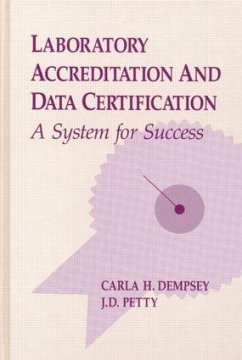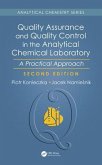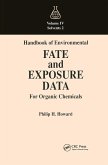Carla H. Dempsey, Jimmie D. Petty
Laboratory Accreditation and Data Certification
A System for Success
Carla H. Dempsey, Jimmie D. Petty
Laboratory Accreditation and Data Certification
A System for Success
- Gebundenes Buch
- Merkliste
- Auf die Merkliste
- Bewerten Bewerten
- Teilen
- Produkt teilen
- Produkterinnerung
- Produkterinnerung
This book provides descriptions of current laboratory accreditation schemes and explains why these schemes fall short of assuring data purchasers that the data produced from accredited laboratories are always quality products. The book then presents a system for laboratory accreditation in conjunction with data certification that assures data purchasers their data are useful for the purposes for which they are intended. Simple quality assurance and quality control techniques, in addition to concepts of total quality management, are described and then applied to the environmental laboratory…mehr
Andere Kunden interessierten sich auch für
![Green Organic Chemistry in Lecture and Laboratory Green Organic Chemistry in Lecture and Laboratory]() Green Organic Chemistry in Lecture and Laboratory259,99 €
Green Organic Chemistry in Lecture and Laboratory259,99 €![CRC Handbook of Phase Equilibria and Thermodynamic Data of Copolymer Solutions CRC Handbook of Phase Equilibria and Thermodynamic Data of Copolymer Solutions]() Christian WohlfarthCRC Handbook of Phase Equilibria and Thermodynamic Data of Copolymer Solutions429,99 €
Christian WohlfarthCRC Handbook of Phase Equilibria and Thermodynamic Data of Copolymer Solutions429,99 €![Handbook of Environmental Fate and Exposure Data For Organic Chemicals, Volume V Handbook of Environmental Fate and Exposure Data For Organic Chemicals, Volume V]() Philip H. HowardHandbook of Environmental Fate and Exposure Data For Organic Chemicals, Volume V271,99 €
Philip H. HowardHandbook of Environmental Fate and Exposure Data For Organic Chemicals, Volume V271,99 €![Quality Assurance and Quality Control in the Analytical Chemical Laboratory Quality Assurance and Quality Control in the Analytical Chemical Laboratory]() Piotr KonieczkaQuality Assurance and Quality Control in the Analytical Chemical Laboratory238,99 €
Piotr KonieczkaQuality Assurance and Quality Control in the Analytical Chemical Laboratory238,99 €![Handbook of Environmental Fate and Exposure Data for Organic Chemicals, Volume IV Handbook of Environmental Fate and Exposure Data for Organic Chemicals, Volume IV]() Philip H. HowardHandbook of Environmental Fate and Exposure Data for Organic Chemicals, Volume IV379,99 €
Philip H. HowardHandbook of Environmental Fate and Exposure Data for Organic Chemicals, Volume IV379,99 €![Lignin and Lignans Lignin and Lignans]() Lignin and Lignans304,99 €
Lignin and Lignans304,99 €![The Science of Defoaming The Science of Defoaming]() Peter R. GarrettThe Science of Defoaming379,99 €
Peter R. GarrettThe Science of Defoaming379,99 €-
-
-
This book provides descriptions of current laboratory accreditation schemes and explains why these schemes fall short of assuring data purchasers that the data produced from accredited laboratories are always quality products. The book then presents a system for laboratory accreditation in conjunction with data certification that assures data purchasers their data are useful for the purposes for which they are intended. Simple quality assurance and quality control techniques, in addition to concepts of total quality management, are described and then applied to the environmental laboratory industry. This "System For Success" was developed from real problems and real solutions within the industry and represents an integration of proven techniques that offer a better way to ensure quality laboratory data is obtained. Laboratory Accreditation: A Workable Solution is a must for government officials, environmental professionals, independent environmental laboratories, hazardous waste disposal industries, chemical manufacturers, QA professionals, and testing laboratories.
Hinweis: Dieser Artikel kann nur an eine deutsche Lieferadresse ausgeliefert werden.
Hinweis: Dieser Artikel kann nur an eine deutsche Lieferadresse ausgeliefert werden.
Produktdetails
- Produktdetails
- Verlag: CRC Press
- Seitenzahl: 256
- Erscheinungstermin: 3. Juni 1991
- Englisch
- Abmessung: 240mm x 161mm x 18mm
- Gewicht: 552g
- ISBN-13: 9780873712910
- ISBN-10: 0873712919
- Artikelnr.: 22960619
- Herstellerkennzeichnung
- Libri GmbH
- Europaallee 1
- 36244 Bad Hersfeld
- gpsr@libri.de
- Verlag: CRC Press
- Seitenzahl: 256
- Erscheinungstermin: 3. Juni 1991
- Englisch
- Abmessung: 240mm x 161mm x 18mm
- Gewicht: 552g
- ISBN-13: 9780873712910
- ISBN-10: 0873712919
- Artikelnr.: 22960619
- Herstellerkennzeichnung
- Libri GmbH
- Europaallee 1
- 36244 Bad Hersfeld
- gpsr@libri.de
Carla Dempsey is a Program Development Manager for Environmental Programs at Lockheed Engineering and Sciences Company in Washington D.C. She is responsible for locating opportunities in the environmental field for applying the high technology that has been developed at Lockheed. Ms. Dempsey has prior experience at the Environmental Protection Agency where she was the Quality Assurance Coordinator for the Superfund Contract Laboratory Program. She has also been a Project Manager with environmental consulting firms. Before focusing on environmental issues, she assisted the U.S. Navy design a national quality assurance program as the Quality Assurance Manager for the Laboratory Division at Puget Sound Naval Shipyard in Bremerton, WA. Ms. Dempsey received her BS. in Chemistry from Gonzaga University in Spokane, WA and her MS in Chemistry from the University of Washington in Seattle. J. D. Petty is the Director of Analytical Research and Quality Control at the Ferment a Animal Health Co. The research involves development of methodology to determine a wide array of pharmaceutical ingredients in a variety of matrices. In addition Dr. Petty is responsible for ensuring that all analytical data meet the requirements of FDA Good Laboratory Practice and Good Manufacturing Practice regulations. Dr. Petty has prior experience as the Chief of the Quality Assurance Research Branch of the EPA's Environimal Monitoring Systems Laboratory at Las Vegas and as the Chief Chemist of the U.S. Fish and Wildlife Services' National Fisheries Contaminant Research Center located in Columbia, Missouri. Dr. Petty received his BS in Chemistry from Central Missouri State University in 1970 and his Ph.D. in Organic Chemistry from the University of Missouri-Columbia in 1975. Dr. Petty has authored and coauthored over 50 publications on a wide range of research topics.
I. Laboratory Accreditation and Certification
Historical Perspective and Definition of Need
Definition of Need
The Goals of Laboratory Accreditation / Certification
Process Inspection Versus Product Inspection
Evolution and Description of the Current Programs
The Role of the Government in Accreditation and Evaluation
The Role of Professional and Trade Organizations
The Role of the Laboratory Industry
The Role of Private Certification Companies
Statement of the Problem: Current Programs Do Not Effectively Meet the Goals
The Solution
an Introduction
II. Certification, Accreditation, Registration and Listing
Definition of Terms
Use of the Terms Accreditation and Certification
Current Use of Related Terms
Public Perception and Confidence of Programs and Terms
III. Principles of Laboratory Accreditation
Description
Strengths and Weaknesses
Public Perception and Confidence and Scientific Validity
Cost and Benefits
Effectiveness and Integrity
IV. Principles of Product Certification
As Related to Laboratory Accreditation
Description
Third
Party Product Certification Programs
Listing Programs
Strengths and Weaknesses
Public Perception and Confidence and Scientific Validity
Cost and Benefits
Effectiveness and Integrity
Description of Current "Certification" Programs
Description of Current "Listing" Programs
Critique
Do the Current Programs Meet Product
Certification Requirements?
Product Certification and Data Inspection
The Critical Link
V. The Environmental Protection Agency Contract Laboratory Program
A De Facto Certification Program that Includes Principles of Each System
Introduction
Pre
award Elements
Post
award Elements
CLP Strengths and Weaknesses
Successful Application of the CLP
Public Perception and Confidence and Scientific Validity
Cost and Benefits
Effectiveness and Integrity
VI. The Total Quality Management Approach
Description
Understanding Total Quality Management
Deming's Fourteen Points
Total Quality Management and Its Relation to Accreditation and Certification Systems
The Purpose of Certification and Accreditation in Relation to Vendors and Purchasers
Vendor Accreditation and Vendor Certification
Are These Systems Needed?
Improvement of the Current Programs through Application of Total Quality Management Principles
VII. The Solution
A System for Independent Third
Party Certification of Analytical Data
Description
Appraisal of Process Capability
Appraisal of the Ability of the Laboratory to Perform
Specifications and Requirements of the System
The Role of Accreditation and Certification Bodies and the Role of Data Purchasers
Third
Party Certification Authorities
Oversight of Third
Party Organizations
VIII. Implementation Considerations
Introduction
Roadblocks to Implementation of a National Program
Reluctance of the Federal Government
Reluctance of Laboratories to Accept a National Program
The General Approach
A Schematic Design
Accreditation and Certification Criteria
Tiered Approach to Defining Requirements
The Future System
Quality Assurance or Chaos?
New Requirements
Old Requirements
Redesigned
Responsibility for Development of Quality Specifications and Requirements
Responsibility for System Logistics
Distribution of Accreditation and Certification Information
Appeals, Arbitrations, and Liability
The Importance of Education
Cost and Benefits
Additional Hurdles to Implementation
IX. Performance Evaluation Materials
A Vital Element of the System
Introduction
Definition of Terms
Current Use of Blind Samples in Laboratory Evaluation Programs
Real Matrix Samples Versus Synthetic Samples
Are Both Types Valid?
Internal Versus External QC Samples
The Use of Performance Evaluation Materials by Industry
The Optimal Solution
Use of Performance Evaluation Materials by Both Accreditation Programs and Data Purchasers
Use of Performance Evaluation Samples Versus Split Samples
Use of Performance Evaluation Materials to Assist in Data Review and Assessment
Performance Evaluation Materials Suppliers
Cost of Performance Evaluation Samples
Use of Performance Evaluation Materials in the ProposedAccreditation and Certification Program
X. Application of this System to Non
Environmental Laboratories
Comparison of the Mission of Non
Environmental Testing Laboratories to Environmental Testing Laboratories
Key Elements of the System that Apply to All Laboratory Types
Applicability of the Concept
XI. The Impact of National Laboratory Accreditation on Internal Quality Assurance and Control
Internal Laboratory Quality Assurance
Research and Development QA Versus Contract Chemistry QA
Elements of a Formal Internal Quality Assurance Program
Internal Quality Assurance
Why It Is Needed?
Internal QA
More Critical Than Ever Before
XII. The Role of Industry in Laboratory Accreditation and Data Certification
Introduction
Industry's Role
Criteria for Data Purchase
Cost of Poor Data to Industry
Industry's Responsibility
Tools to Assist Industry in Meeting Their Responsibility
Future Responsibilities for Industry
XIII. Summary of the Problem and the Solution
Restatement of the Problem
The Problem
Stated in a Slightly Different Way
Synopsis of the Solution
Potential Future Application of the Solution
Limited Recommendations
XIV. The Future in the 90's
Introduction
The CLP
Is it a Good Model
Or A Failure?
Projections for the Future for Environmental Data
Final Hope for the Future
Index.
Historical Perspective and Definition of Need
Definition of Need
The Goals of Laboratory Accreditation / Certification
Process Inspection Versus Product Inspection
Evolution and Description of the Current Programs
The Role of the Government in Accreditation and Evaluation
The Role of Professional and Trade Organizations
The Role of the Laboratory Industry
The Role of Private Certification Companies
Statement of the Problem: Current Programs Do Not Effectively Meet the Goals
The Solution
an Introduction
II. Certification, Accreditation, Registration and Listing
Definition of Terms
Use of the Terms Accreditation and Certification
Current Use of Related Terms
Public Perception and Confidence of Programs and Terms
III. Principles of Laboratory Accreditation
Description
Strengths and Weaknesses
Public Perception and Confidence and Scientific Validity
Cost and Benefits
Effectiveness and Integrity
IV. Principles of Product Certification
As Related to Laboratory Accreditation
Description
Third
Party Product Certification Programs
Listing Programs
Strengths and Weaknesses
Public Perception and Confidence and Scientific Validity
Cost and Benefits
Effectiveness and Integrity
Description of Current "Certification" Programs
Description of Current "Listing" Programs
Critique
Do the Current Programs Meet Product
Certification Requirements?
Product Certification and Data Inspection
The Critical Link
V. The Environmental Protection Agency Contract Laboratory Program
A De Facto Certification Program that Includes Principles of Each System
Introduction
Pre
award Elements
Post
award Elements
CLP Strengths and Weaknesses
Successful Application of the CLP
Public Perception and Confidence and Scientific Validity
Cost and Benefits
Effectiveness and Integrity
VI. The Total Quality Management Approach
Description
Understanding Total Quality Management
Deming's Fourteen Points
Total Quality Management and Its Relation to Accreditation and Certification Systems
The Purpose of Certification and Accreditation in Relation to Vendors and Purchasers
Vendor Accreditation and Vendor Certification
Are These Systems Needed?
Improvement of the Current Programs through Application of Total Quality Management Principles
VII. The Solution
A System for Independent Third
Party Certification of Analytical Data
Description
Appraisal of Process Capability
Appraisal of the Ability of the Laboratory to Perform
Specifications and Requirements of the System
The Role of Accreditation and Certification Bodies and the Role of Data Purchasers
Third
Party Certification Authorities
Oversight of Third
Party Organizations
VIII. Implementation Considerations
Introduction
Roadblocks to Implementation of a National Program
Reluctance of the Federal Government
Reluctance of Laboratories to Accept a National Program
The General Approach
A Schematic Design
Accreditation and Certification Criteria
Tiered Approach to Defining Requirements
The Future System
Quality Assurance or Chaos?
New Requirements
Old Requirements
Redesigned
Responsibility for Development of Quality Specifications and Requirements
Responsibility for System Logistics
Distribution of Accreditation and Certification Information
Appeals, Arbitrations, and Liability
The Importance of Education
Cost and Benefits
Additional Hurdles to Implementation
IX. Performance Evaluation Materials
A Vital Element of the System
Introduction
Definition of Terms
Current Use of Blind Samples in Laboratory Evaluation Programs
Real Matrix Samples Versus Synthetic Samples
Are Both Types Valid?
Internal Versus External QC Samples
The Use of Performance Evaluation Materials by Industry
The Optimal Solution
Use of Performance Evaluation Materials by Both Accreditation Programs and Data Purchasers
Use of Performance Evaluation Samples Versus Split Samples
Use of Performance Evaluation Materials to Assist in Data Review and Assessment
Performance Evaluation Materials Suppliers
Cost of Performance Evaluation Samples
Use of Performance Evaluation Materials in the ProposedAccreditation and Certification Program
X. Application of this System to Non
Environmental Laboratories
Comparison of the Mission of Non
Environmental Testing Laboratories to Environmental Testing Laboratories
Key Elements of the System that Apply to All Laboratory Types
Applicability of the Concept
XI. The Impact of National Laboratory Accreditation on Internal Quality Assurance and Control
Internal Laboratory Quality Assurance
Research and Development QA Versus Contract Chemistry QA
Elements of a Formal Internal Quality Assurance Program
Internal Quality Assurance
Why It Is Needed?
Internal QA
More Critical Than Ever Before
XII. The Role of Industry in Laboratory Accreditation and Data Certification
Introduction
Industry's Role
Criteria for Data Purchase
Cost of Poor Data to Industry
Industry's Responsibility
Tools to Assist Industry in Meeting Their Responsibility
Future Responsibilities for Industry
XIII. Summary of the Problem and the Solution
Restatement of the Problem
The Problem
Stated in a Slightly Different Way
Synopsis of the Solution
Potential Future Application of the Solution
Limited Recommendations
XIV. The Future in the 90's
Introduction
The CLP
Is it a Good Model
Or A Failure?
Projections for the Future for Environmental Data
Final Hope for the Future
Index.
I. Laboratory Accreditation and Certification
Historical Perspective and Definition of Need
Definition of Need
The Goals of Laboratory Accreditation / Certification
Process Inspection Versus Product Inspection
Evolution and Description of the Current Programs
The Role of the Government in Accreditation and Evaluation
The Role of Professional and Trade Organizations
The Role of the Laboratory Industry
The Role of Private Certification Companies
Statement of the Problem: Current Programs Do Not Effectively Meet the Goals
The Solution
an Introduction
II. Certification, Accreditation, Registration and Listing
Definition of Terms
Use of the Terms Accreditation and Certification
Current Use of Related Terms
Public Perception and Confidence of Programs and Terms
III. Principles of Laboratory Accreditation
Description
Strengths and Weaknesses
Public Perception and Confidence and Scientific Validity
Cost and Benefits
Effectiveness and Integrity
IV. Principles of Product Certification
As Related to Laboratory Accreditation
Description
Third
Party Product Certification Programs
Listing Programs
Strengths and Weaknesses
Public Perception and Confidence and Scientific Validity
Cost and Benefits
Effectiveness and Integrity
Description of Current "Certification" Programs
Description of Current "Listing" Programs
Critique
Do the Current Programs Meet Product
Certification Requirements?
Product Certification and Data Inspection
The Critical Link
V. The Environmental Protection Agency Contract Laboratory Program
A De Facto Certification Program that Includes Principles of Each System
Introduction
Pre
award Elements
Post
award Elements
CLP Strengths and Weaknesses
Successful Application of the CLP
Public Perception and Confidence and Scientific Validity
Cost and Benefits
Effectiveness and Integrity
VI. The Total Quality Management Approach
Description
Understanding Total Quality Management
Deming's Fourteen Points
Total Quality Management and Its Relation to Accreditation and Certification Systems
The Purpose of Certification and Accreditation in Relation to Vendors and Purchasers
Vendor Accreditation and Vendor Certification
Are These Systems Needed?
Improvement of the Current Programs through Application of Total Quality Management Principles
VII. The Solution
A System for Independent Third
Party Certification of Analytical Data
Description
Appraisal of Process Capability
Appraisal of the Ability of the Laboratory to Perform
Specifications and Requirements of the System
The Role of Accreditation and Certification Bodies and the Role of Data Purchasers
Third
Party Certification Authorities
Oversight of Third
Party Organizations
VIII. Implementation Considerations
Introduction
Roadblocks to Implementation of a National Program
Reluctance of the Federal Government
Reluctance of Laboratories to Accept a National Program
The General Approach
A Schematic Design
Accreditation and Certification Criteria
Tiered Approach to Defining Requirements
The Future System
Quality Assurance or Chaos?
New Requirements
Old Requirements
Redesigned
Responsibility for Development of Quality Specifications and Requirements
Responsibility for System Logistics
Distribution of Accreditation and Certification Information
Appeals, Arbitrations, and Liability
The Importance of Education
Cost and Benefits
Additional Hurdles to Implementation
IX. Performance Evaluation Materials
A Vital Element of the System
Introduction
Definition of Terms
Current Use of Blind Samples in Laboratory Evaluation Programs
Real Matrix Samples Versus Synthetic Samples
Are Both Types Valid?
Internal Versus External QC Samples
The Use of Performance Evaluation Materials by Industry
The Optimal Solution
Use of Performance Evaluation Materials by Both Accreditation Programs and Data Purchasers
Use of Performance Evaluation Samples Versus Split Samples
Use of Performance Evaluation Materials to Assist in Data Review and Assessment
Performance Evaluation Materials Suppliers
Cost of Performance Evaluation Samples
Use of Performance Evaluation Materials in the ProposedAccreditation and Certification Program
X. Application of this System to Non
Environmental Laboratories
Comparison of the Mission of Non
Environmental Testing Laboratories to Environmental Testing Laboratories
Key Elements of the System that Apply to All Laboratory Types
Applicability of the Concept
XI. The Impact of National Laboratory Accreditation on Internal Quality Assurance and Control
Internal Laboratory Quality Assurance
Research and Development QA Versus Contract Chemistry QA
Elements of a Formal Internal Quality Assurance Program
Internal Quality Assurance
Why It Is Needed?
Internal QA
More Critical Than Ever Before
XII. The Role of Industry in Laboratory Accreditation and Data Certification
Introduction
Industry's Role
Criteria for Data Purchase
Cost of Poor Data to Industry
Industry's Responsibility
Tools to Assist Industry in Meeting Their Responsibility
Future Responsibilities for Industry
XIII. Summary of the Problem and the Solution
Restatement of the Problem
The Problem
Stated in a Slightly Different Way
Synopsis of the Solution
Potential Future Application of the Solution
Limited Recommendations
XIV. The Future in the 90's
Introduction
The CLP
Is it a Good Model
Or A Failure?
Projections for the Future for Environmental Data
Final Hope for the Future
Index.
Historical Perspective and Definition of Need
Definition of Need
The Goals of Laboratory Accreditation / Certification
Process Inspection Versus Product Inspection
Evolution and Description of the Current Programs
The Role of the Government in Accreditation and Evaluation
The Role of Professional and Trade Organizations
The Role of the Laboratory Industry
The Role of Private Certification Companies
Statement of the Problem: Current Programs Do Not Effectively Meet the Goals
The Solution
an Introduction
II. Certification, Accreditation, Registration and Listing
Definition of Terms
Use of the Terms Accreditation and Certification
Current Use of Related Terms
Public Perception and Confidence of Programs and Terms
III. Principles of Laboratory Accreditation
Description
Strengths and Weaknesses
Public Perception and Confidence and Scientific Validity
Cost and Benefits
Effectiveness and Integrity
IV. Principles of Product Certification
As Related to Laboratory Accreditation
Description
Third
Party Product Certification Programs
Listing Programs
Strengths and Weaknesses
Public Perception and Confidence and Scientific Validity
Cost and Benefits
Effectiveness and Integrity
Description of Current "Certification" Programs
Description of Current "Listing" Programs
Critique
Do the Current Programs Meet Product
Certification Requirements?
Product Certification and Data Inspection
The Critical Link
V. The Environmental Protection Agency Contract Laboratory Program
A De Facto Certification Program that Includes Principles of Each System
Introduction
Pre
award Elements
Post
award Elements
CLP Strengths and Weaknesses
Successful Application of the CLP
Public Perception and Confidence and Scientific Validity
Cost and Benefits
Effectiveness and Integrity
VI. The Total Quality Management Approach
Description
Understanding Total Quality Management
Deming's Fourteen Points
Total Quality Management and Its Relation to Accreditation and Certification Systems
The Purpose of Certification and Accreditation in Relation to Vendors and Purchasers
Vendor Accreditation and Vendor Certification
Are These Systems Needed?
Improvement of the Current Programs through Application of Total Quality Management Principles
VII. The Solution
A System for Independent Third
Party Certification of Analytical Data
Description
Appraisal of Process Capability
Appraisal of the Ability of the Laboratory to Perform
Specifications and Requirements of the System
The Role of Accreditation and Certification Bodies and the Role of Data Purchasers
Third
Party Certification Authorities
Oversight of Third
Party Organizations
VIII. Implementation Considerations
Introduction
Roadblocks to Implementation of a National Program
Reluctance of the Federal Government
Reluctance of Laboratories to Accept a National Program
The General Approach
A Schematic Design
Accreditation and Certification Criteria
Tiered Approach to Defining Requirements
The Future System
Quality Assurance or Chaos?
New Requirements
Old Requirements
Redesigned
Responsibility for Development of Quality Specifications and Requirements
Responsibility for System Logistics
Distribution of Accreditation and Certification Information
Appeals, Arbitrations, and Liability
The Importance of Education
Cost and Benefits
Additional Hurdles to Implementation
IX. Performance Evaluation Materials
A Vital Element of the System
Introduction
Definition of Terms
Current Use of Blind Samples in Laboratory Evaluation Programs
Real Matrix Samples Versus Synthetic Samples
Are Both Types Valid?
Internal Versus External QC Samples
The Use of Performance Evaluation Materials by Industry
The Optimal Solution
Use of Performance Evaluation Materials by Both Accreditation Programs and Data Purchasers
Use of Performance Evaluation Samples Versus Split Samples
Use of Performance Evaluation Materials to Assist in Data Review and Assessment
Performance Evaluation Materials Suppliers
Cost of Performance Evaluation Samples
Use of Performance Evaluation Materials in the ProposedAccreditation and Certification Program
X. Application of this System to Non
Environmental Laboratories
Comparison of the Mission of Non
Environmental Testing Laboratories to Environmental Testing Laboratories
Key Elements of the System that Apply to All Laboratory Types
Applicability of the Concept
XI. The Impact of National Laboratory Accreditation on Internal Quality Assurance and Control
Internal Laboratory Quality Assurance
Research and Development QA Versus Contract Chemistry QA
Elements of a Formal Internal Quality Assurance Program
Internal Quality Assurance
Why It Is Needed?
Internal QA
More Critical Than Ever Before
XII. The Role of Industry in Laboratory Accreditation and Data Certification
Introduction
Industry's Role
Criteria for Data Purchase
Cost of Poor Data to Industry
Industry's Responsibility
Tools to Assist Industry in Meeting Their Responsibility
Future Responsibilities for Industry
XIII. Summary of the Problem and the Solution
Restatement of the Problem
The Problem
Stated in a Slightly Different Way
Synopsis of the Solution
Potential Future Application of the Solution
Limited Recommendations
XIV. The Future in the 90's
Introduction
The CLP
Is it a Good Model
Or A Failure?
Projections for the Future for Environmental Data
Final Hope for the Future
Index.








